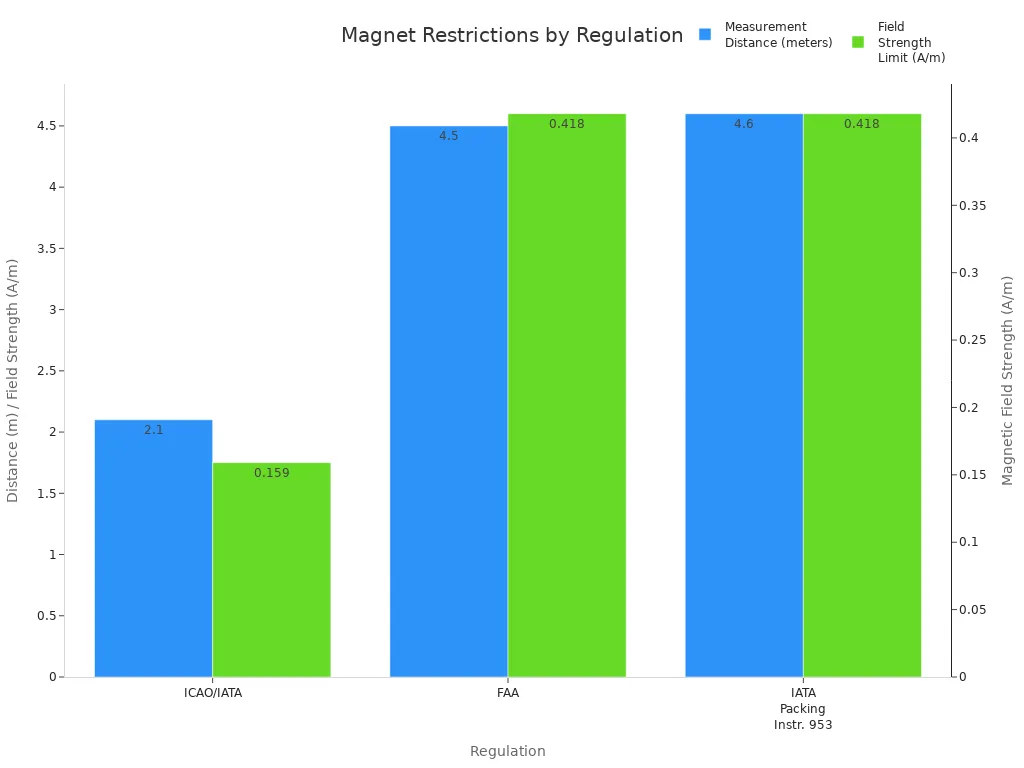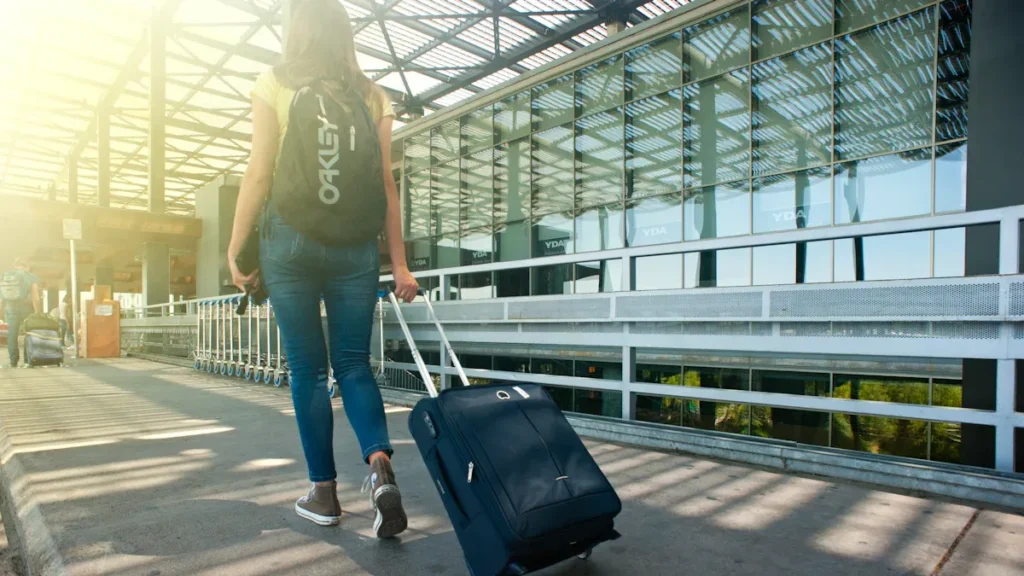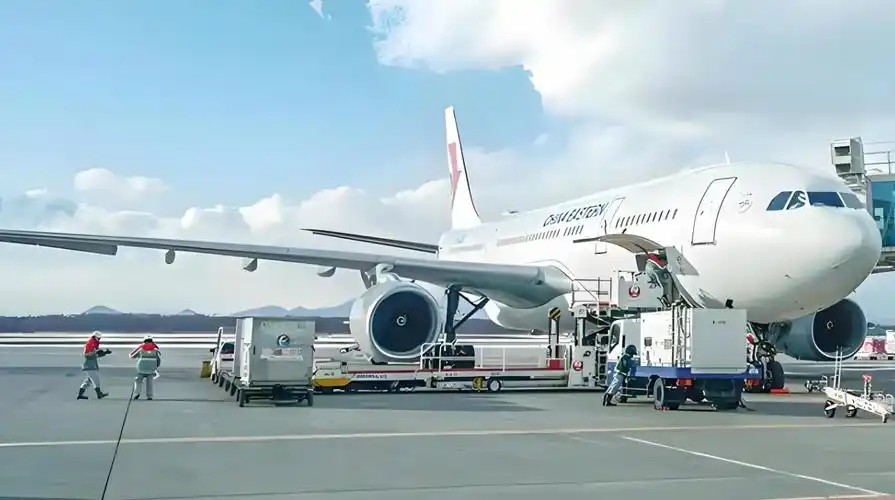You might wonder, Can you bring magnets on a plane? The answer is yes—most magnets are allowed on planes, but you need to follow some rules. If you ask, can you bring magnets on a plane? TSA says most household magnets are fine. Strong magnets may have extra restrictions, so always double-check before you pack. With the right info, you can travel with magnets without any trouble.
Key Takeaways
Most household magnets, like fridge magnets and magnetic toys, are okay in carry-on and checked bags. You do not need special rules for these. Strong magnets, like neodymium and industrial types, have strict limits. They need special packaging, labels, and airline approval. Magnets with a magnetic field stronger than 0.00525 gauss at 15 feet are not allowed on passenger planes. This rule helps keep flights safe. Always check your magnet’s strength before you travel. If you are not sure, ask the TSA or your airline. This helps you avoid problems at security. Pack magnets together in a pouch or box. This helps security officers check them quickly and easily. Use steel plates, bubble wrap, or padding to cover strong magnets. This keeps their magnetic fields inside during travel. Tell the airline and security staff if you have strong or large magnets. Fill out any needed paperwork to stop delays or fines. Small magnets inside things like phones and laptops are safe to bring. These usually do not cause problems.
Can You Bring Magnets on a Plane
TSA Rules
When you ask, Can you bring magnets on a plane, the first place to check is the TSA. The TSA lets you bring most household magnets in your carry-on or checked bags. You can pack fridge magnets, magnetic toys, and small magnetic accessories without any trouble. The TSA only gets strict when you try to bring strong magnets.
The TSA uses these rules to decide if a magnet is strong:
They measure the magnetic field at 15 feet from the package.
If the field is more than 0.00525 gauss at that distance, the magnet is too strong.
If a compass moves more than 2 degrees near your magnet, it counts as dangerous.
Strong magnets need special packaging, labels, and paperwork.
You should use bubble wrap, cardboard, or even steel containers to shield strong magnets.
The TSA follows these rules to keep flights safe.
Most people never have to worry about these limits. Every day, magnets are usually safe for flying with magnets. If you have a big or industrial magnet, you need to check the rules before you pack.
Tip: If you are not sure about your magnet’s strength, ask the tsa or your airline before your trip.
FAA and IATA Limits
The TSA works with the FAA and IATA to set air travel rules for magnets. These groups want to keep airplanes safe from magnetic interference. The FAA and IATA say that any magnet with a field stronger than 0.00525 gauss at 15 feet cannot go on a passenger plane. If your magnet is that strong at 7 feet, it must be labeled as “magnetized material” and treated as hazardous. These rules help protect the plane’s navigation and electronic systems.
If your magnet is weaker than 0.002 gauss at 7 feet, you do not need to worry about extra rules. Most consumer magnets, like the ones in headphones or toys, are much weaker than these limits. You can pack them in your bag without any special steps.
Here’s a quick look at how the FAA and IATA rules compare:
Regulation | Measurement Distance | Magnetic Field Strength Limit | Additional Notes |
|---|---|---|---|
ICAO/IATA | 2.1 meters | 0.159 A/m | Magnetized materials must be identified and documented if they exceed this limit |
FAA | 4.5 meters (15 feet) | 0.418 A/m (0.00525 gauss) | Applies for air carriage; also considers compass deflection at 7 feet |
IATA Packing Instruction 953 | 4.6 meters (15 feet) | 0.418 A/m (0.00525 gauss) or compass deflection ≤ 2° | Specifies packaging and testing requirements |

If you plan on flying with magnets that are very strong, you must follow these air travel rules. Otherwise, your magnet could get taken away at the airport.
Airline Policies
Each airline can set its own rules for magnets, so you should always check before you fly. Most airlines let you bring small magnets, like fridge magnets or magnetic toys, in both your carry-on and checked bags. These magnets are safe because their magnetic fields are low.
Airlines do not allow magnets with a field above 5.25 milligauss at 15 feet.
Large or industrial magnets often break this rule and are not allowed.
Antique magnets can be risky if you do not know their strength.
If you must bring a strong magnet, pack it with bubble wrap and keep it away from electronics.
Some airlines want you to label and declare strong magnets at check-in.
If you ship strong magnets as air freight, you need special paperwork and packaging.
Personal magnets in things like headphones, speakers, or laptops are usually fine. You can pack them in your bag without worry. If you are ever unsure, ask your airline before your trip.
Note: Can you bring magnets on a plane? Yes, but always check with the tsa and your airline if you have a strong or unusual magnet. Following these steps makes flying with magnets easy and safe.
Types of Magnets Allowed

Fridge Magnets
You probably have a few fridge magnets at home. The good news is you can take fridge magnets on a plane without any trouble. These magnets are small and weak, so they do not cause problems for airport security or the airplane’s systems. Most airlines and the TSA say fridge magnets are allowed on planes in both your carry-on and checked bags.
You might wonder if you can take fridge magnets on a plane as souvenirs or gifts. The answer is yes! Many travelers bring back fridge magnets from their trips. Just pack them in a pouch or small box to keep them safe. If you collect magnets, you can take fridge magnets on a plane every time you travel.
Tip: Keep your fridge magnets together in a bag or pouch. This makes it easy for security to check them if needed.
Magnetic Toys
Magnetic toys are popular with kids and adults. You can bring most magnetic toys on a plane, but you should know a few rules. The TSA and airlines focus on the strength of the magnets inside the toys. Most magnetic toys have weak magnets, so they are allowed on planes.
The U.S. Department of Transportation says magnetic items with a field strength less than 0.002 gauss at 7 feet are not restricted.
Toys with stronger magnets, like rare-earth magnets, can be dangerous. These magnets are not safe for children and should be kept away from them.
Airlines do not ban magnetic toys, but they do not allow toys with very strong magnets that could affect the plane’s instruments.
The TSA may check remote-controlled toys more closely, but magnetic toys are not banned from carry-on or checked bags.
If you pack magnetic toys, make sure they are not too strong. Keep them in a box or bag to avoid losing pieces. Always check the toy’s label or ask the airline if you are unsure.
Industrial Magnets
Industrial magnets are much stronger than fridge magnets or toys. These magnetic items can cause problems for airplanes if not packed correctly. Most industrial magnets are not allowed on planes unless you follow strict rules.
Airlines and the IATA say industrial magnets must have a weak magnetic field at a certain distance. If the field is too strong, you cannot bring them on a plane.
You must pack these magnets with special shielding, like steel plates or thick padding, to block the magnetic field.
You need a test report from a professional to show the magnet is safe for air travel.
The magnet must have labels and paperwork that say it is safe and allowed on planes.
If the magnet is too strong or heavy, airlines may refuse to carry it.
Industrial magnets often need special handling. If you need to fly with one, contact the airline before your trip. They will tell you what steps to follow. Most travelers do not need to worry about these rules unless they work with strong magnets for a job.
Prohibited Magnets
Not all magnets can go through airport security. Some magnets are too strong to take on a plane. If your magnet has a very strong magnetic field, you could have problems at the airport. The rules say magnets with a magnetic field over 0.00525 gauss at 15 feet are not allowed on commercial planes. This rule keeps the plane’s instruments safe from problems.
You might ask which magnets break this rule. The answer is usually strong, rare-earth magnets. These are neodymium, dysprosium, and samarium magnets. You find them in industrial machines, science tools, or powerful gadgets. If you have one and it is not packed or shielded correctly, you cannot bring it on a plane. The U.S. Department of Transportation puts these magnets in hazard class 9. This means they are dangerous goods. The International Air Transport Association (IATA) also has strict rules for these magnets. If your magnet is too strong, you cannot bring it on a plane, no matter how you pack it.
Here are some magnets you cannot bring on a plane:
Large neodymium magnets from speakers or machines
Industrial lifting magnets
Rare-earth magnets from science labs that are not shielded
Magnetic assemblies that move a compass needle from far away
Note: If you do not know your magnet’s strength, test it before you travel. If a compass moves more than two degrees near your magnet, you probably cannot bring it on a plane.
You do not need to worry about small magnets in toys or souvenirs. You can bring fridge magnets on a plane with no trouble. These magnets are weak and safe for flying. The main worry is with magnets that can mess up the plane’s navigation or communication systems.
If you are not sure, ask your airline or check the TSA website before you pack. It is better to be safe than to lose your magnet at security. Only magnets that follow the safety rules can go on planes.
Packing Magnets
Carry-On Bags
You might want to put magnets in your carry-on bag. Small things like fridge magnets or magnetic toys are usually okay. Security officers see these items a lot. But sometimes, magnets in your carry-on can cause problems. Security scanners might flag them because they look like other banned items. If the magnet is strong, it could mess with the plane’s instruments. Some airlines or security staff may ask you to take magnets out of your bag or even take them away.
Tip: If you bring magnets in your carry-on, keep them together in a pouch or box. This helps security check them faster.
Strong magnets or magnetic tools should not go in your carry-on. Security might stop you, and you could lose your items or face delays. Always check your airline’s rules before packing magnets for a flight.
Checked Luggage
Most people find checked luggage is the safest way to bring magnets. Airlines and airport workers like you to check magnets, especially if they are strong or for work. Here’s why checked bags are better:
Magnets in checked luggage are less likely to cause trouble at security.
Checked bags go through special X-ray machines that can handle magnets.
Baggage handlers know how to deal with magnetic tools or bases.
Checked luggage lets you pack magnets so they do not mess with the plane’s equipment.
If you forget to declare a strong magnet, you could get fined or your bag could be delayed. Checked bags make it easier to follow the rules for magnets.
Many field technicians say they always use checked bags for magnets. They do not have problems when they follow the right steps. If you fly with magnets for work, check them in and tell the airline if needed.
Shielding and Safety
Shielding is very important when you ship magnets or bring them on a plane. You want to keep the magnetic field inside the package. Here are some good ways to pack magnets safely:
Measure the magnetic field at 15 feet from your package. If it is over 0.00525 gauss, you cannot ship it by air.
Use steel or other strong materials to shield the magnet. This helps keep the magnetic field from leaking out.
Pack magnets with their poles facing each other. This cancels out some of the magnetic force.
Add padding or dividers in the box so magnets do not move around.
If your magnet is strong, you must put a magnetized material warning label on the package and fill out a Dangerous Goods Declaration Form.
If the magnetic field is below 0.002 gauss at 7 feet, you do not need special labels or paperwork.
Requirement Category | Details |
|---|---|
Magnetic Field Limits | - Less than 0.002 gauss at 7 feet: not regulated. |
Packaging Requirements | - Opposing polarities. |
Labeling Requirements | - Magnetized material warning label on the address side for air transport. |
Documentation | - Dangerous goods declaration required for air shipment. |
Regulatory References |
Note: If you are not sure about the rules for shipping magnets, ask your airline or a shipping expert. These steps help keep everyone safe when you bring magnets on a plane.
When you follow these tips, flying with magnets is much easier. You will not have delays, fines, or lose your items. Safe packing and the right labels help everyone have a smooth trip.
Magnetic Devices on Board
When you fly, you probably bring magnetic devices. Many things you use every day have magnets inside them. You might worry if these magnetic items are safe on a plane. Most of the time, you can bring them with you. You just need to follow some easy rules.
Electronic Devices
You use electronic devices all the time. Most of them have small magnets inside. Here are some magnetic devices you might pack for your trip: – Cell phones and smartphones – Laptops and tablets (like iPads) – Headphones and earbuds – Cameras and camcorders – Smartwatches and fitness trackers – Portable speakers – Calculators and e-readers
These devices use magnets for speakers, motors, or sensors. Airlines and the TSA let you bring these magnetic items in your carry-on or checked bags. You do not need to worry about the magnets inside. The main thing to watch out for is the batteries, especially lithium-ion batteries.
Tip: Always keep spare batteries in your carry-on bag. Never put loose batteries in checked luggage.
Here are some battery rules you should know:
Device Type | Allowed in Carry-On | Allowed in Checked Bag | Special Rules |
|---|---|---|---|
Phones/Tablets | Yes | Yes | Batteries must stay inside |
Laptops | Yes | Yes | Remove if asked at security |
Spare Batteries | Yes | No | Protect each battery |
Power Banks | Yes | No | Check airline limits |
If you bring extra batteries, keep them in their original box or cover the ends with tape. This helps keep everyone safe.
Magnetic Accessories
You might also pack things that use magnets. These can be magnetic phone mounts, charging cables, stylus pens, or magnetic jewelry. Most of these are small and safe to bring on a plane. You can put magnetic accessories in your carry-on or checked bag.
Some tools, like screwdrivers or small flashlights, may have magnets too. If you need to bring tools, check with your airline first. Some airlines have rules about sharp or heavy tools, but the magnets inside are usually not a problem.
Note: If you have a big or very strong magnet in an accessory, put it in your checked bag and tell the airline.
You do not need to tell security about most magnetic devices on board. Security officers see these items every day. If you are not sure, ask before you fly. This helps you avoid problems and keeps your trip easy.
Strong Magnets
Neodymium Magnets
Neodymium magnets are some of the strongest magnets you can buy. You might find them in speakers, headphones, or science kits. These magnets are much more powerful than regular fridge magnets. Because of their strength, they can cause problems if you bring them on a plane.
Here’s what makes neodymium magnets tricky for air travel:
They create strong magnetic fields that can reach far from the magnet.
If you pack them wrong, they can snap together and break. The pieces can fly off and hurt someone or damage your stuff.
The International Air Transport Association (IATA) has strict rules for these magnets. If the magnetic field is too strong at a certain distance, you cannot bring them on a plane.
You need to use special packaging, like thick foam and iron plates, to keep the magnetic field inside the box.
Sometimes, you must even use wooden crates or try to make the magnet weaker before flying.
Tip: If you want to bring a neodymium magnet, always check its strength and use lots of padding and shielding.
Safety Concerns
Strong magnets, like neodymium magnets, can cause real safety risks on airplanes. The biggest worry is electromagnetic interference (EMI). This means the magnet’s field can mess with the plane’s electronics.
Here’s why airlines and the TSA care about strong magnets:
Strong magnetic fields can disrupt the plane’s navigation and communication systems. This can make it hard for pilots to know where they are or talk to air traffic control.
Magnetic interference can mess up sensors, gyroscopes, and magnetometers. These tools help the plane fly safely.
If a magnet is strong enough, it can even cause signal loss or errors in the plane’s computers.
A real-life example shows how dangerous this can be. In 2021, a drone in Sydney lost control and crashed because of strong magnetic interference. The drone’s compass and sensors stopped working, and it hit a hotel window. No one was seriously hurt, but this shows what can happen if strong magnets are not handled right.
Note: Even though planes have shielding, very strong magnets can still cause problems. That’s why airlines set strict limits.
Special Arrangements
If you need to fly with a strong magnet, you must follow special steps. You cannot just toss it in your bag and hope for the best.
Here’s what you should do:
Measure the magnetic field strength. If it is above 0.00525 gauss at 15 feet, you cannot bring it on a passenger plane.
Use steel plates or other shielding to block the magnetic field.
Pack the magnet tightly with foam or padding so it cannot move or break.
Label the package as “magnetized material” if it is strong enough to need special handling.
Fill out all paperwork, like a Dangerous Goods Declaration, if the airline asks for it.
Always tell your airline and the TSA about your magnet before you fly.
Step | What You Need to Do |
|---|---|
Measure | Check the magnetic field at 15 feet |
Shield | Use steel plates or iron to block the field |
Pack | Add foam and keep the magnet from moving |
Label | Mark as “magnetized material” if needed |
Declare | Tell the airline and fill out forms |
Reminder: If you do not follow these steps, your magnet could get taken away, or your flight could be delayed. Always play it safe when flying with strong magnets.
Security Screening

When you travel with magnets, you might wonder what happens at airport security. Security officers want to keep everyone safe, so they use several tools and steps to check your bags and personal items. If you know what to expect, you can move through security faster and avoid surprises.
X-Ray Process
At the airport, your journey through security starts with a few important steps. You walk through a metal detector, also called a magnetometer. This machine checks for large metal objects. Most small magnets, like fridge magnets or magnetic toys, do not set off alarms. If you carry a strong or large magnet, the detector might beep. In that case, a security officer uses a hand-held wand to check you more closely.
Your bags and coats go through an X-ray scanner. This machine lets security officers see what is inside without opening your bag. The X-ray can spot magnets, electronics, and other metal items. If the officer sees something unusual, they might ask you to open your bag. Sometimes, they do a manual search to make sure everything is safe.
Here’s what usually happens at security:
You walk through a metal detector.
Your bags and coats go through an X-ray scanner.
Security officers check for large metal objects.
If the detector beeps, you get checked with a hand-held wand.
Officers may ask you to remove large electronics or liquids.
If they see something odd, they may open your bag for a closer look.
Tip: Keep your magnets together in a pouch or box. This makes it easier for security to check them quickly.
Declaring Magnets
Most travelers do not need to declare small magnets. If you only have fridge magnets, magnetic toys, or small accessories, you can keep them in your bag. Security officers see these items every day. You do not need to fill out any forms or tell anyone about them.
If you travel with strong magnets, things change. Strong magnets can cause problems for the plane’s instruments. If you have a magnet that is big, heavy, or very powerful, you should tell the airline and security officers before your flight. You may need to show paperwork or special labels. Sometimes, you must fill out a Dangerous Goods Declaration Form.
Here’s when you should declare magnets:
Magnet Type | Declare at Security? | Special Steps Needed? |
|---|---|---|
Fridge Magnets | No | None |
Magnetic Toys | No | None |
Strong Magnets | Yes | Label, paperwork, notify staff |
Industrial Magnets | Yes | Shielding, forms, airline notice |
Note: If you are not sure about your magnet, ask a security officer or airline staff. It is better to ask than to have your item taken away.
By following these steps, you can make your trip through security smooth and stress-free. Always pack your magnets safely and be ready to answer questions if needed.
Quick Tips and Checklist
Summary Table
Here’s a handy table to help you remember what you can and can’t bring when transporting magnets on a plane. Use this as a quick reference before you pack your bags!
Magnet Type | Carry-On Bag | Checked Bag | Special Steps Needed? |
|---|---|---|---|
Fridge Magnets | ✅ | ✅ | None |
Magnetic Toys | ✅ | ✅ | None |
Small Accessories | ✅ | ✅ | None |
Neodymium Magnets | ❌/✅ | ✅ | Shield, label, may need to declare |
Industrial Magnets | ❌ | ✅* | Shield, label, declare, paperwork |
Prohibited Magnets | ❌ | ❌ | Not allowed |
*Some industrial magnets may not be allowed at all. Always check with your airline first.
Legend:
✅ = Allowed
❌ = Not allowed
❌/✅ = Allowed only if weak and properly packed
Last-Minute Reminders
Before you head to the airport, take a minute to double-check your packing. These reminders will help you avoid problems at security and make your trip smoother.
Keep all magnets together in a pouch or small box. This makes it easy for security to check them.
If you have strong magnets, use steel plates or thick padding to shield them. Label the package if needed.
Always check your magnet’s strength. If you’re not sure, test it with a compass or ask your airline.
Put small magnets and magnetic toys in your carry-on or checked bag. Both are usually fine.
Never try to hide strong magnets. Declare them at check-in if required.
Read your airline’s rules about transporting magnets. Each airline can have different policies.
If you need to bring industrial or rare-earth magnets, contact the airline before your trip. You may need special paperwork.
Keep spare batteries for magnetic devices in your carry-on, not your checked bag.
Arrive at the airport early if you have strong or unusual magnets. Security might take extra time to check your bag.
When in doubt, ask! It’s better to ask a TSA officer or airline staff than to lose your magnet at security.
Remember: Most travelers never have trouble with magnets if they follow these tips. Safe packing and honest answers make flying with magnets easy.
You can bring most magnets on a plane if you follow the rules. Always check the latest TSA and airline guidelines before you pack. Safe packing helps you avoid problems at security. Keep your magnets together and shield strong ones if needed.
Remember: Most travelers fly with magnets without any trouble when they prepare ahead. Stay informed, pack smart, and enjoy your trip!
FAQ
Can you bring magnets in your carry-on bag?
Yes, you can bring small magnets like fridge magnets or toys in your carry-on. Security may ask to see them, so keep them together in a pouch or box for easy inspection.
Do magnets set off airport security alarms?
Most small magnets do not set off alarms. If you carry a large or strong magnet, security might check your bag. You can help by packing magnets neatly and being ready to answer questions.
Are neodymium magnets allowed on planes?
You can only bring neodymium magnets if they are weak and packed safely. Strong neodymium magnets need special shielding and paperwork. If you are not sure, ask your airline before you travel.
Can you mail magnets instead of flying with them?
Yes, you can mail magnets. The post office has rules for strong magnets, so check their guidelines. Mailing is a good option for large or industrial magnets that are hard to bring on a plane.
What happens if you forget to declare a strong magnet?
If you forget to declare a strong magnet, security may take it away or delay your bag. You could also get a fine. Always tell the airline or TSA if you have a strong or unusual magnet.
Can magnets damage your electronics during a flight?
Small magnets in your bag will not hurt your electronics. Strong magnets can cause problems if they touch devices. Keep strong magnets away from laptops, phones, and credit cards to stay safe.


